|
|
$100 Entire printed facsimile set. All 22 issues.  |
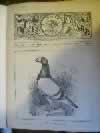 |
This facsimile of the fist issue of volume 7 #1, published
March 10, 1893 has a wonderful picture of a Dragon on the cover. The editorial
of this issue, details the growth of the magazine from an irregular monthly
seven years previous to the 24 page weekly is was then. Circulation had become
very strong with subscribers in many other countries. It is interesting that
a magazine with such a long run simply disappeared from site and knowledge
from the hobby, only to reappear in this long lost volume. The layout is
very much as pigeon magazines today, with short breed, show, club, and advice
articles, along with a slew of interesting advertising for pigeons, medicines
and other assorted sundry supplies. The most thorough article in this issue
covers the New York Show.
Download as a free PDF file |
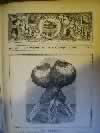 |
This facsimile of the second issue of Volume
7 #2, March 17th displays a pair of pouters being the specialties of George Foust of Rhinebeck
New York. George's interest obviously extended beyond pouters as his full page ad in this issue illustrates. Not only did he have Pouters available,
but Jacobins, Carriers, Turbits, Tumblers and Magpies fill out his loft.
Need a cure for canker? He has that available too. There is also discussion
about the fist adoption of bands. Some must have been rather fancy being
made of enameled copper. I bet there are band collectors out there that would
covet one of these. A few contributors also use pen names, and it appears
that a pen name may have the same affect as a mask - the articles can be
rather direct.
Download as a free PDF file |
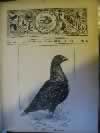 |
This facsimile of the third issue of Volume
7, #3, March 24, shows a Show Homer. Interesting what you can learn from these old
magazines. This is even a bit earlier than I had previously believed that
the Show Homer was created, and known about in America. Mr. Woodfield,
of England, presented the picture and informative article about the new popular
English breed to the publisher. He also melds both the Show Homer and Exhibition
Homer as the same, although they are currently dealt with quite separately.
Rollers are also provided a lengthier article by W. Stevens, as he describes
what constitutes the roller, apart and distinct from tumblers.Free downloaded as a Adobe PDF file
Download as a free PDF file |
 |
This facsimile of the fourth issue of
volume 7, #4, March 31, shows some paraphernalia of a standard pigeon loft. The perch design
is rather unique with a sloped board beneath the perch to deflect feces.
There are a lot of club reports included in this issue, with the editor reporting
on and promoting the formation of new breed clubs. He laments that the American
Columbarian Association has discontinued the use of point cards at their
last meeting in Louisville, but is happy to see that the chief of the World's
Fair exhibition department has consented to reduce the time for the pigeon
exhibit from two weeks to just one. I wonder what he would think today, when
the World's Fair has reduced the time of the pigeon exhibit to none. But
then, we are still debating the merits of point cards, nearly one hundred
and fifty years late.
Download as a free PDF file |
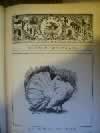 |
This facsimile of the fifth issue of volume
7, #5, published April 7, 1893 displays Frank Gilbert's champion of Nashville,
along with a more in depth piece about fantails in general and the movement
to create a national Fantail Club. Of course national in 1893, really went
everything east of the Mississippi. There is also a piece about trumpeters,
where one would swear it was written yesterday in the way of description
with statement like the rose covering the entire skull in a downward directions,
its back and breast are so broad and stalwart in proportion and on and on.
There is also a short piece on Owls, and of course the weekly Homing and
Tippler updates as well.

Download as a free PDF file |
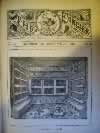 |
This facsimile of the six issue of volume
7, #6, published April 14, 1893 "Princess" Gilbert's 92 hatch white fantail champion
being a cross of both the English and Scottish type, Magpie, Owl, Barb
information notes as well as many other short articles. A very interesting
copy of a piece of pigeon history.

Download as a free PDF file |
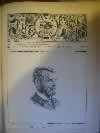 |
This facsimile of the seventh issue of
volume 7, #7, published April 21, 1893 has a picture on the cover of the famous
pigeon fancier C. E. Twombly who breed Swallows at the time . The issue
also covers, also includes wonderful pictures of "Ben Hur" Gilbert's winning
two year old Fantail cock and of Ryan & Gould's winning blue Turbit.
There are many small articles providing a diverse amount of information including
Fantails being shipped to Besey in CA, Fick's Swallows, Jacobin, Owl, Homer,
and Tippler, club's notes, as well as dozens of very interesting ads.
Download as a free PDF file |
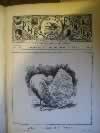 |
This facsimile of the eight issue of volume
7, #8, published April 28, 1893 sports a picture of "Queen" Gilbert's 1892 white
Fantail hen on the cover. "At Philadelphia she was in the pink of condition
and showed up in great shape, having the same 'wavy' motion as her father
'Derby'." Articles about the starting days of the American Pigeon Club and
their effort to get pigeon only shows established in the U.S., birds being
shipped between Australia and New Zealand, which included Jacobins, Swallows,
Turbits, Owls and others. A short article about Levering's Turbits, including
a picture of his 1892 hen that took first in New York. There are many small
articles providing a diverse amount of information about various club activities,
as well as dozens of very interesting ads.
Download as a free PDF file |
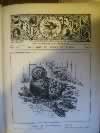 |
This facsimile of the ninth issue of volume
7, #9, published May 5, 1893 displays a picture of Rommel's mottled Trumpeter
hen that took first at New York on the cover. She was imported by Rommel
from Smyth of Ireland. There is a very nice article and picture of the Nun
included in the article. Nuns of yesterday certainly are different than those
we see in the show rooms today. Curious what the Turbit Standard said back
in 1893, well this issue will inform you. There is also a nice article about
Long-faced Tumblers and Swallows with the Swallow article providing a drawing
depicting what a Swallow should look like. There are many small articles
providing a diverse amount of information about various club activities,
as well as dozens of very interesting ads.
Download as a free PDF file |
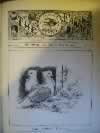 |
This facsimile of the tenth issue of volume
7, #10, published May 12, 1893 shows a picture of a pair of yellow Turbits owned
by William Levering of Baltimore, buy were bred by Thomas LeCuyer. They won
first in New York and were considered by the editor to be the finest Turbits
in America. He provides more descriptive information on the birds and the
persons involved in part of his editorial. There is also a nice article by
Hepworth about exporting Tipplers to Australia, as well as many small articles
providing a diverse amount of information about various club activities,
as well as dozens of very interesting ads.
Download as a free PDF file |
 |
This facsimile of the eleventh issue of
volume 7, #11, published May 19, 1893 presents us a picture of a almond Tumbler
owned by T. S. Gaddes of Baltimore, considers by the editor to be the best
in the country. Included within the cover is a request from the Inspector
General of the War Department seeking information on racing homer clubs.
While this is well before WWI, it is obvious from this request that the value
of homing pigeons for communication purposes was known to the U.S. military
even then. It appears that shipping had its difficulties at the time as well.
There are also many small articles providing a diverse amount of information
about various breed club activities, as well as dozens of very interesting
ads.
Download as a free PDF file |
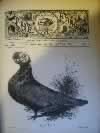 |
This facsimile of the twelfth issue of
volume 7, #12, published May 26, 1893 provides sports a picture of Barb from England.
Along with the many small articles providing a diverse amount of information
about various breed club activities and dozens of very interesting ads, this
issue has a lengthier article about long face tumblers. There is quite a
bit of discussion about balds and beards. The editorial deals with the
establishment of the first ever exclusive pigeon show being promoted by the
American Pigeon Club. Other shorter pieces include among others, The Turbit
Scale, An Archangel Club Budding, Korb's Fantail.
Download as a free PDF file |
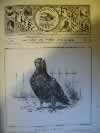 |
This facsimile of the thirteenth issue of volume 7, #13, published
June 2, 1893 editorial provides additional information about the champion
Barb gracing the cover. This red Barb, owned by Mr. W. White of Baltimore,
won at New York is the sire of a family of champions, including his yellow
son that won best Barb in both 1889 and 1890. The yellow son has the distinction
of being the first ever Barb crossing back to England and did well at the
Crystal Palace. Much more information is provided, not only about this particular
breed, but others as well, including a fairly in depth article about Magpies.
Download as a free PDF file |
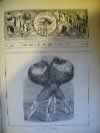 |
This facsimile of the fourteenth issue of volume 7, #14, published
June 9th, editorial provides us with a defense of the honorable Mr. Gilbert. Evidently
acrimony is not a new element of the game. He goes on to tell us Mr. Gilbert
quite unwarrantedly is "... subjected to a most vigorous fusillade of personal
attacks, biting sarcasm and insulting slurs." Not having seen the other
publication, we have no way of knowing what these attacks and insults were,
but it does provide one with a broader understanding of our hobby, both good
and bad. But the article I found the most interesting in the particular issue
is about Pouter classification. The author of this article actually visited
Robert Fulton of London just after he sold out his first printing of his
book. He notes in part "... I shall never forget the beautiful collection
of Pouters he showed us. These birds were very evenly marked."
Download as a free PDF file |
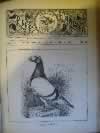 |
This facsimile of the fifteenth issue of volume 7, #15, published
June 16, 1893 editorial is most optimistic, foreseeing a future where pigeons
periodicals, such as this one, come out not only weekly, periodicals devoted
solely to each of the many popular varieties of the pigeon family. Well as
we now know it was not to pass. What did come to pass though was the creation
of sound and enduring specialty clubs, which then were only barely starting
to form, and a lot of space is devoted to that effort in nearly every issue.
There is also a featured piece on Long Faced Tumblers by Richard Woods, the
author of Pigeons and all about them that goes into some length explaining
the colors and color depth. But I found a small piece on Smerles most intriguing.
Here in the beginning days of long races, the author tells us about his pure
bred Smerles from Belgium and how well they are performing.
Download as a free PDF file |
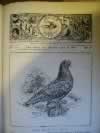 |
This facsimile of the sixteenth issue of volume 7, #16, published
June 23, 1893 editorial provides more information about the Red Rose Wing
Tumbler found on the cover. This specimen, winning at both New York and
Philadelphia, was bred by Mr. F. S. Walton, the secretary and treasurer of
the American Tumbler Club, and is undoubtedly the finest Tumbler in America.
The editor is not enamored with the artist's rendition, and finds that we
have a dearth of artist's than can accurately show a pigeon to its best.
I don't share his sentiments in this particular instance, but you are the
judge.
Download as a free PDF file |
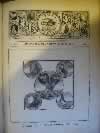 |
This facsimile of the seventeenth issue of volume 7, #17, published
June 30, 1893 editorial provides us with a resume of Mr. Sinnette a popular
travel writer and bird fancier now residing in England but also having been
employed in Paris. In the pigeon world Turbits have gained his heart and
he has become quite the authority on that breed. The article I found most
interesting from this issue was that of John Kuhn's wild two week vacation
visiting fanciers around the country. Remember now this was 1893 and travel
was not just filling up the car and running off to another state.
Download as a free PDF file |
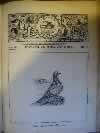 |
This facsimile of the eighteenth issue of volume 7, #18, published
July 7, 1893 editorial is a hodgepodge of issues, but the one I found
entertaining was that of a proposal by the American Pigeon Club to have a
champion section in their shows. Only birds that had won champion class at
local shows would have the right to compete in this class, and it was viewed
as a way to encourage large range participation and a setting for regional
comparisons. It is hard for me to pick another favorite article from this
issue, because there are so many I enjoyed. The Fantail, Homer, Pouter, Pedigree,
and the continuation of the two week whirl wind tour all vied for my favorite.
At the end, I just could not decide.
Download as a free PDF file |
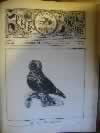 |
This facsimile of the nineteenth issue of volume 7, #19, published
July 14, 1893 editorial is perhaps providing the first hint of financial
difficulty. He reprints, in total, an article about the wisdom of paying
even small bills in a timely manner. John Kuhn completes his series of visiting
pigeon fanciers around the country in this issue with so many breeders and
breeds that it is just impossible to name them all in this short space. There
is also an in depth article this issues cover breed - the Trumpeter, tracing
the breeds development in general and voice in particular. But being an Owl
breeder myself, the article detailing the head of the Turbit was the jewel
in this issue. Learning first hand the when and where and how the Owl/Turbit
breed separated was fascinating indeed.
Download as a free PDF file |
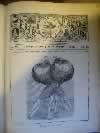 |
This facsimile of the twentieth issue of volume 7, #20, published
August 18, 1893 editorial explains why there had been a month delay in issuing
the "weekly" magazine. It appears that pigeon magazines had trouble then
as well as now. A landlord had seized the property and a court order was
needed to put the magazine back into business. It must have been hectic and
troublesome time. An astute visitor to the page will notice that the same
cover picture graces the fourteenth issue as well. I do not know how much
longer The Fancier stayed viable, as I only have two more issues. The issue
itself though is of the same high quality. A featured article about the Magpie
is most illustrative. We also see here the beginning of a standard with a
point system for the various desired features of the Magpie.
Download as a free PDF file |
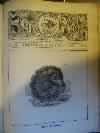 |
This facsimile of the twenty-first issue of volume 7, #21, published
August 25, 1893 editorial covers what all editors must do from time to time
- that of self promotion, particularly advertising. So many things stay the
same. But he does not belabor the points and he provides snapshots of success
that other are making in the hobby. As one would suspect from the cover,
there is an in-depth article about them by their leading promoter at the
time, F. M. Gilbert. But the one that caught my attention most was the article
about Owls, not Turbits. Owls and Turbits up until this time are often seen
more as a related breed rather than distinct. Here we start leering about
when, why and where they became distinct breeds rather than two varieties
within the single breed family.
Download as a free PDF file |
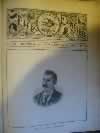 |
This facsimile of the twenty second issue of volume 7, #22, published September
1, 1893 editorial provides a resume of George Ewald in his continuation of
who's who in the pigeon world. He was secretary of the Columbarian Association
in America at the time. The Columbarian Association is most probably the
very first club devoted exclusively to pigeons in America. He was instrumental
in creating the exclusive pigeon show, which is common now in America, rather
than the more common birds shows found elsewhere. I guess it is debatable
if this really worked for the benefit of the hobby or not. There is strength
in numbers and separating pigeon breeders out from other birds fanciers may
not really have been in the best interest of all bird fanciers. While there
are two featured articles about Long Faced Tumblers and Rollers, I found
the piece by Richard Woods about Ornithosis (one eyed cold) most illuminating.
We have struggled for over a century now with this ailment, and I am very
glad for modern medicines contribution to our hobby.
Download as a free PDF file |



